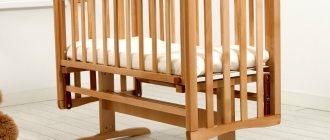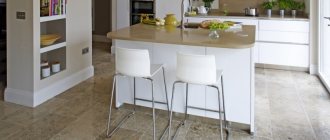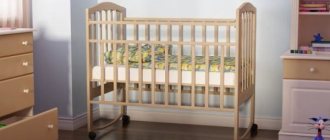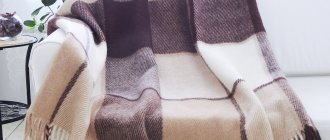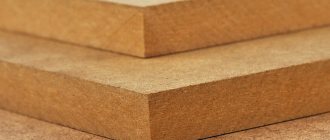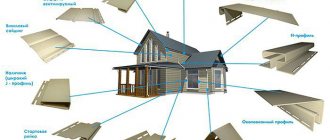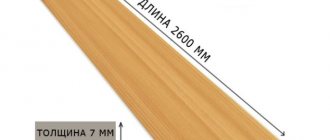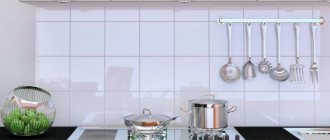You don’t always need to spend significant sums to make a room look beautiful. Today, a small budget is enough to create the appropriate effect. An example is the use of PVC panels. Everyone can choose a product to suit their taste, because they are available in different versions and colors. The dimensions of PVC panels for walls are also selected individually.
Types of PVC panels according to purpose
This finishing material is widely used for finishing walls and ceilings. The former have characteristics of greater strength, the latter are lighter. When choosing, you should pay special attention to the purpose of the model you like.
Attention! PVC wall and ceiling panels are not interchangeable.
Dimensions of PVC panels - wall models have a length of 2.5 ÷ 6 m, a width of 25 ÷ 30 cm and a thickness of 6 ÷ 10 mm. Considering that the ceiling is not subject to mechanical stress during operation, ceiling products are made thinner. The sizes of PVC panels for the ceiling are 6 ÷ 10 m, 25 ÷ 30 cm and 4 ÷ 5 mm. Manufacturers offer products with matte, glossy and painted surfaces.
Using PVC panels as a finishing material, you can do without preliminary preparation of the base. Installation can be carried out without the use of special equipment, which significantly expands the possible scope of use.
Wall panels are highly durable
Technical characteristics of PVC panels
Plastic panels have excellent properties. It is for this reason that they have been used in interior decoration for a long time. The immediate area of application for the material was the kitchen area. The ceiling surfaces were made of plastic lining. Over time, the lining began to be mounted on the wall. A wide range of sizes and shades has appeared.
Advantages of plastic lining:
- moisture resistant;
- practical;
- easy to install;
- durable;
- wear-resistant.
It is also worth noting the fire resistance of the material and its inability to be exposed to temperature changes. All this is due to the dense structure of the plastic. It has no pores.
Due to the fact that the main advantage of plastic panels is moisture resistance, they can be installed in rooms with high air humidity. Only here there are certain rules according to which the surface preparation and internal insulation of the room are carried out.
The practicality of plastic is due to the ease of maintenance. Since the material is not able to absorb dirt, its surface can be easily cleaned with a simple damp cloth. Cleaners and detergents can be used on some surfaces.
Important. Do not use abrasive products that can damage glossy plastic panels.
The service life of the panels reaches 80 years. It all depends on the manufacturer of the material and the quality of the product. For this reason, it is better to purchase plastic for interior decoration only from trusted sellers. It is worth noting that throughout their entire service life and with proper care, PVC panels do not change their external design. The surface does not fade in the sun, which makes it possible to use them in finishing the facade of any building. To do this, certain panel parameters are selected.
The material is also easy to install. Work can be done independently.
Dimensions of PVC panels - standard dimensions
Standard dimensions of the material are determined by the type of panels. There are slats on sale with a thickness of 5-10 mm, the former are more fragile and require care during installation.
Advice! Forms of standard sizes are suitable for finishing small rooms, and for cladding the ceiling of a large plane, you should choose elongated slats - they are easier to install.
Dimensions of PVC ceiling panels accepted by manufacturers:
- lining – narrow and long dies 10 cm wide, up to 3 m long;
- reinforced lining up to 3 m long, but 12.5 cm wide;
- sheet panels with a width of 80-203 cm and a length of 1.5-4.05 m are manufactured;
- elongated dies 25 cm wide and 6 m long.
On a note! Before purchasing material, you need to take into account the width of the room and the layout. For example, with a room width of 3 m, lamellas 6 m long can be rolled out with virtually no residue by cutting the shapes in half.
Interior ideas with PVC ceilings
Plastic ceiling panels are an inexpensive but quite practical way of finishing. The frame structure is quickly assembled and lasts a long time. And thanks to its resistance to temperature and humidity changes, it is suitable for all types of rooms.
Advantages and disadvantages of the material
Main advantages:
- plastic panels are insensitive to moisture, therefore suitable for kitchens and bathrooms;
- they do not deteriorate due to leakage, the plates can be removed, dried and put back in place;
- the material is lightweight, making it easy to install even without help; installation indoors takes only a few hours;
- they are inexpensive;
- a layer of air between the stiffeners increases sound absorption and also helps retain heat;
- you can hide wires or additional insulation above the ceiling;
- lighting is easily integrated into PVC panels;
- plastic tolerates temperature changes well from -80 ° C to + 80 ° C, therefore it is suitable for balconies and loggias;
- the material is durable, manufacturers provide a guarantee of about 10 years;
- if necessary, it is easy to replace individual panels;
- It is enough to take care of it, just wipe it with a sponge or a soapy rag, but products with abrasive particles, strong alkalis or acids are not suitable;
- They are available in a variety of designs, have many colors, textures and patterns, so they are selected for almost any interior.
But the material also has its drawbacks:
- seams are visible on the panels, so it will not be possible to create a uniform ceiling; this drawback is also noticeable in seamless options, although their cracks are less noticeable;
- the height of the room is reduced, as with all hanging structures;
- poor-quality finishes burn and release toxic substances when heated, as well as immediately after installation;
- It will not be possible to mount a multi-level ceiling, since there are no suitable elements and accessories.
Properties, advantages and disadvantages
Any material used for finishing has its drawbacks. These PVC products include fragility (the panels are hollow inside) and the ability to release toxic substances upon fire.
The list of advantages will be longer:
- Long service life.
- Wide decorative possibilities. The color palette is multifaceted.
- Reasonable prices.
- Wash well with soapy water.
- Light weight per 1 m².
- High combustion temperature (almost +400˚С).
- High resistance to mold, fungi, moisture.
- The dimensions of the panels allow you to cover any area.
- Installation of the products is simple and does not require special skills.
- If damaged, the element is easily replaced.
- Good quality sound, thermal and waterproofing.
- The thermoplastic structure of polyvinyl chloride, made from salt, gas and oil, is safe (environmentally friendly) at natural temperatures. It is also used for the production of food containers, food packaging, and toys for children.
Dimensions of PVC panels - standard parameters
PVC panels are two sheets of polyvinyl chloride connected by stiffening ribs. One of the faces is the front one, designed using a specialized technique, that is, it has decor. PVC panels not only perform a decorative function when decorating a room, but also create additional insulation in the house. TO
In addition, plastic products protect the surface of the ceiling from exposure to aggressive environments, and also hide some of the ceiling’s imperfections (irregularities, leaks).
Manufacturers produce PVC panels not only for ceiling surfaces, but also for vertical surfaces (walls). Basically, when choosing a finishing product made of polyvinyl chloride, you should pay attention to the standard sizes of the slats. But manufacturers make decorative panels not only according to the standard, so you can order panels of any size.
The length of the slats can be different: 270 cm, 3 m, 395 cm and 1.2 meters. Thanks to this variety, it is possible to install it on the required surface with a large area. Panels with a length of 595 cm are in greatest demand, because they can be used as a finishing material for small and large rooms.
The width of the building material can vary from 10 to 50 cm. Basically, panels with a product width of 10 and 12.5 cm have a visible joint. The most popular slats are 25 cm wide; when installed, virtually no visible joints are formed. Panels with a width of 300 and 375 mm are used as finishing material for any surface, but they must be at least 10 mm thick.
The thickness of the products depends entirely on their purpose. The ceiling slats have a thickness of 5 to 8 mm. For such products, strength does not matter. Wall building materials have the greatest thickness (10 mm), unlike previous options, because they must withstand mechanical damage and exposure to ultraviolet radiation.
For joining and fastening panels, manufacturers produce PVC profiles that correspond to the parameters of the planks. The length of such profiles varies from 270 to 600 cm.
Variety of shapes and size standards of PVC
PVC finishing is also classified by form factor, which differs in size and variety of shapes. The sizes of sandwich roofing panels will differ slightly.
Rack sheets
Lamels - or slatted, most often imitate lining, and therefore have the appropriate dimensions. They look like familiar, standard finishing boards:
- length – from 90 cm to 3 m:
- the width ranges from 13.5 to 30 cm. The parameter depends on what kind of profile the lamella reproduces: ship timber - single or double, herringbone, and so on.
Decorative wall
The thickness of the wall panels is standard for any form factor and is 8–12 mm. There is quite a wide range of decorative panels for walls from Leroy Merlin.
Other dimensional parameters of the seamless slatted material:
- length – 260, 270 and 300 cm;
- width – from 15 to 50 cm.
Tiled
The tile material is usually seamless, as it imitates stone surfaces, plastered, as well as tiles. The design of wall panels for tiles is extremely diverse - from any shade to any pattern or pattern formed by tiles laid in the right order.
The most popular sizes include the following:
- 30 * 30 cm – often combined: plain and with a pattern, plain and imitating stone;
- 98*98 cm – used for creating paintings and complex drawings.
Leafy
Sheet finishing – differs in the largest sizes. For installation on walls, this is the least labor-intensive option, as it covers a large area. The design can be quite original:
- length – from 98 to 244 cm;
- width – from 50 to 122 cm;
- The thickness of the sheet material is usually less - 3–6 mm. Otherwise, the mounting element - the sheet - turns out to be too heavy.
The video shows the installation of PVC wall panels:
Types of plastic panels
Depending on the parameters, PVC planks are available in different varieties.
Plastic tile panels
The tile material is similar in appearance to ceramic tiles. The standard dimensions of this product are 30x30 cm, 98x98 cm, 100x100 cm, their thickness can vary from 1 to 5 mm. Tile panels can be used in combination with simple tile options that imitate natural stone.
Plastic wall panels
Wall slats are used to decorate wall surfaces. Thanks to a wide range of products, it becomes possible to create an original image in the interior of the room. The width of the products is from 15 to 50cm, the size is 2.6m, 2.7m, 3m, thickness is from 6 to 10mm.
Plastic sheet panels
They are large in size. When working with this type of panel, a significant area is covered - it will be unusual and interesting to design.
Standard sizes: width – 50-122 cm, length – 0.9-2.44 m, thickness – 1-6 mm.
Plastic lining panels
It has a smooth glossy finish and is available in a variety of colors. The connection is made using a male/female locking system, which makes installation easy. Vertical laying of boards visually makes the ceiling higher, and horizontal laying makes the wall wider.
Standard sizes: width – 10-30 cm, length – 0.9-3 m, thickness – 4-8 mm.
Plastic panels with 3D effect
This type of product is used not only in the design of residential buildings and apartments, but also in office buildings and shops. The original drawing allows you to create a unique design in the room. Lamels with this effect imitate natural wood, natural stone, ceramic tiles. Standard parameters: width – 25 cm, 37 cm, 50 cm, dimensions – 2.7 m, 3 m, thickness – from 8 to 10 mm.
With thermal transfer
The production technology of this type of product is carried out in such a way that an image or pattern is displayed on a polymer film, after which this image is transferred to a plastic building material under the influence of high temperatures using specialized equipment. Thermal transfer panels are considered the most popular among homeowners, since they are highly resistant to high temperatures, and installation will not cause any particular difficulties even for a novice builder. The width of the panels is 25 centimeters, the size is 2.7, 3 and 6 meters, the thickness is from 8 to 10 mm.
Laminated products
The method of manufacturing laminated panels is that a film with a pattern and bandage is glued to the front side. This manufacturing method gives the finishing material additional performance characteristics; It is quite difficult to spoil such a model or image. Laminated panels are treated with an antiseptic that prevents small dust particles from settling on the surface of the product. The quality of panels of this type is confirmed by the appropriate quality certificate. Width – 25 centimeters, dimensions – 2.7 and 3 m, thickness – from 8 to 12 mm.
Kinds
Today there is a wide range of products made from polyvinyl chloride on the market. The material is classified depending on its purpose, size, connection method, and surface characteristics.
Tiled
It is possible to imitate different variations of ceramic tiles if you use PVC tile panels for the bathroom or kitchen.
Design solutions for PVC can contain combinations of plastic and ceramic or cover the entire wall surface. There are products on which the tiles are painted with different masonry options: standard, checkerboard, with inserts of individual elements.
PVC material is produced for tiles in sizes 98*98, 30*30, 100*100 mm.
Wall
Wall panels are produced up to 1 cm thick, from 2.7 to 4 m long and up to 0.5 m wide.
The choice of interior options that can be realized using polyvinyl chloride products is unlimited.
Manufacturers offer elements of calm monochromatic colors, bright patterns, decorated with floral designs or abstract compositions.
Wall panels with the same joints can be easily combined with each other, thus further increasing the design possibilities of the product.
Using additional elements (corners, connectors), it is easy to finish complex areas, slopes, and corners with plastic.
Leafy
For wall finishing, there is another type of finishing material - in the form of sheets, with a length of up to 4 m, a width of 50 cm to 2.3 m. Products of this type are: thin - 1 mm or thicker - 30 mm.
A distinctive feature of such PVC panels is that their dimensions allow one element to cover a large area with minimal effort, which is convenient during installation.
Sheet material imitates various embossed or smooth surfaces:
- slate;
- mosaic;
- tiles;
- brick;
- wood.
For example, only the “mosaic” PVC type is available in the following versions: Fruit, Relax, Vanilla, Turquoise, White, Terrazzo Naples, with patterns of various colors.
Lining
A stylish, aesthetic appearance of the room can be created if you use material that is made to look like lining.
Along with low maintenance, low load on the wall, complete immunity to corrosion, and 100% moisture resistance, the buyer receives a reliable, simple structure made to look like sanded wood.
The material is produced 48 mm thick, up to 30 cm wide and 0.9 to 3 m long.
The most common 2 options:
- “Polka” (with a narrow type locking system);
- Eurolining (with a standard size lock).
With 3D effect
Ceramic tiles, wood, and natural stone coated with a layer of varnish can be imitated well if you use panels with full-color 3D printing.
The interior is made using a composition of ornaments and paintings made up of 3D drawings.
An unlimited color palette, seamless structure, good heat and sound insulation qualities, but not without several drawbacks:
- the price of some types of PVC is high;
- you need to make lathing during installation, which will somewhat reduce the space of the room.
With thermal transfer
Polyvinyl chloride with thermal transfer is produced in entire collections. Technologies make it possible to apply patterns and images to polymer film quickly and efficiently. The pattern on the surface is fixed at high temperatures.
Product length – from 2.7 to 6 m, thickness – 0.8-1 cm, width – 25 cm.
The variety of patterns decorating plastic makes it possible to create an original design for a bathroom or kitchen, while simultaneously providing waterproofing, protection from mold and rot, and the absence of cracking over time.
Laminated products
The image is glued to the front part of the PVC panel so that a protective laminated layer is formed on top. It protects the pattern from damage, thereby improving the performance parameters of the product.
The PVC product is available in thicknesses up to 12 mm, length 2 m and width 25 cm.
To correctly calculate the required amount of material, you need to measure the surface area and subtract the squares for the openings for doors and windows.
The quantity per package most often depends on the thickness of the material. There are packs of 6-10 pieces. Knowing the area of one panel, it is easy to calculate how many pieces are needed.
How to calculate the required quantity?
Before you begin calculating the required amount of building material, you need to find out the perimeter of the working surface on which PVC panels will be mounted in the future. Afterwards, along the general perimeter, it is necessary to calculate the area of the existing openings, then the resulting difference must be divided by the perimeter of the finishing product.
Let's consider an example where the external walls of a one-story house with an area of 6x8 meters and a height of 2.5 meters will be faced with PVC slats. This room has 4 window openings and 1 door. In this case, PVC panels with parameters of 2.5 mx30 cm will be used.
Total wall surface perimeter: (6 + 6 + 8 +
x2.5 = 70 m2.
We calculate the difference between the total area of the building and the openings of the rooms: 70-10.62 = 59.38 m2.
Area of 1 PVC product: 2.5x0.3 = 0.75 m2.
We calculate the required number of panels for work: 59.38 / 0.75 = 79.17 pcs.
The resulting number must be rounded up. As a result, 80 pieces of PVC panels are required for cladding a one-story house.
When purchasing decorative plastic panels, it is necessary to take into account not only the room parameters, but also the installation method. In this case, you should take into account the price category of the parts, since long panels differ significantly from short slats, but, in turn, this does not affect the quality of the products. Also, when finishing the walls, decide on the thickness of the finishing building material, because the thicker the panels, the better the sound and heat insulation in the room.
Types of PVC ceiling tiles
The range of ceiling lamellas used for continuous cladding of ceilings usually offers four main types of panels:
- Standard eurolining is long and narrow three-meter slabs with a reinforced locking system, so the joints between the lamellas are clearly visible even with careful installation and adjustment of the seams;
- The Polish version, or lamellas with hidden locks, differs from the previous one only in the width of the locking edge, so it is possible to cover the ceiling with one continuous slab, with virtually no visible joints;
- PVC panels with two or three sections, this type is also called large lining, due to the fact that the material is most often used for cladding ceilings over a large area;
- Panels of increased width, most often double-row or single-row slabs, are used for high ceilings in rooms with a large area.
Eurolining
The increase in the width of the PVC panel is due to the fact that it is recommended to do the ceiling cladding with a minimum number of joints, which not only improves the appearance of the decorative finish, but also significantly speeds up the process of laying it on the sheathing. On the market you can find lining and wide panels with two or even three rows of internal ribs. This material has significantly greater rigidity, so it is used for floors more than 3 m wide.
Recommendations for working with plastic
Before installing the finishing product, it is necessary to keep the panels in the room where such installation is required. The product must be acclimatized. This is necessary so that the building material gets used to the ambient temperature.
In addition to finishing materials, you will need additional elements:
- inner corner;
- initial profile;
- finishing profile;
- plinth.
Installation begins from the corner of the room towards the window or door. First, the inner corner is installed. The slats must be cut to size and the slabs must be cut to suit the installation method.
The plastic product is inserted into the corner profile and mounted on the sheathing. You can use a mechanical stapler for this, but clamps are considered the best option. They are installed at the bottom of the groove and fastening is carried out through the hole in the clamp. This fastening method does not deform the plastic product, and also ensures 100% fastening of the building material. Fasteners are selected at the rate of 2 dowels per 1 meter of profile and 2 self-tapping screws with large plugs per 1 meter of PVC plank size.
Subsequent elements are assembled using the “male in groove” method. In this case, the panels should be joined as tightly as possible. At the end of the cladding, a joint is formed between the wall surface and the floor, which must be covered with a plinth. To seal the joints on the ceiling, a more decorative ceiling plinth is used, which should be in harmony with the overall decoration of the ceiling.
The number of skirting boards is calculated based on the total area of the ceiling. Standard plinth 3 meters long. The total perimeter of the ceiling surface must be divided by the size of the baseboard, after which the resulting value is rounded to a multiple of 3.
Processing with plastic products can be carried out at temperatures from -5 to +50 degrees, so wall decoration in bathrooms and saunas is not carried out. At the locations of switches and sockets, it is necessary to first install special boxes and lay an electrical cable. When installing the strips, you need to drill holes for switches and sockets.
There are 2 methods of gluing plastic products:
- on the crate;
- onto the adhesive solution.
Installation of facing panels or sheet metal can only be done on the frame. This is due to the large size of the products. The frame in this case can be made of wooden or metal slats. The height of the frame depends on the number of irregularities on the working surface.
Plastic building materials in the form of tiles are mainly attached with glue. In this case, it is necessary to carry out preparatory work. The surface must be cleaned of various contaminants, leveled and treated with special means. The tile panels are glued as tightly as possible so that no gaps form under the products.
Features of panels in comparison with different finishing materials
The service life of PVC ceiling panels significantly exceeds the service life of materials of natural origin used for finishing ceilings. With average air humidity and room temperature in the room, the panels can last, on average, 50 years without requiring any restoration work. In addition, the panels protect the ceiling from aggressive influences and hide traces of their influence; for example, traces of a roof leaking from water will never appear on plastic panels.
The panels are very easy to clean - just wipe them with a damp cloth, even without using detergents.
Unlike other finishing materials, for example, whitewash or plaster, over time, PVC ceiling panels of any price do not require updating, and all their care comes down to cleaning with a damp cloth once or twice a year .
Regardless of the size of the PVC ceiling panels, the following advantages can be distinguished from this finishing material:
- the ability to carry out repairs to the premises in a short time and at minimal cost on your own;
- the decorative qualities of the panels allow you to give the room a modern and attractive look;
- PVC panels can be mounted on almost any base;
- fastening PVC ceiling panels allows you to hide unevenness and defects in the ceiling, hide communications and electrical wiring;
- the material is resistant to cold and can be used for finishing entryways, cellars, verandas and other unheated rooms;
- panels improve sound insulation and thermal insulation of the room;
- are resistant to open fire and do not burn;
- characterized by environmental safety for health and the environment;
- are undemanding to care and are distinguished by the versatility of installation locations;
- small amount of waste and dirt during installation.
The disadvantages of PVC panels include:
- the requirements of the Ministry of Emergency Situations prohibit the installation of panels in places that are passable and will serve for the evacuation of residents of the house in case of fire, that is, in corridors, hallways, and on stairs;
- low resistance to mechanical damage;
- when melting, the panels release toxic substances;
- the seam between the panels is not hidden;
- visually noticeable cheapness of finishing.
Technology and installation methods
The strips are fastened using the tongue-and-groove principle with a contact depth, which allows for quick installation and dismantling of the coating. There are two main installation methods: on a frame (cassette) and without it. In the first case, a metal base with rectangular holes is assembled. In the second, such lathing is not needed; only approximately smooth walls and an adhesive or concrete base are enough. The disadvantage of this option is the difficulty of replacing individual elements. The ceiling is finished in only one frame, and this is due to the ability to hide communications and place built-in lighting fixtures, for example, spotlights, in some places. The material is glued to the walls to create the most durable surface. Plastic structures last longer if they do not sag due to pressure on the edges. If the frame method is used, it is better to glue the plastic to the pre-assembled drywall.
External coating of plastic wall cladding
Basically, plastic panels are produced with three options for external coating.
Thermal film
Thermal film forms an additional moisture-proof layer.
The painted surface of the plastic is covered with thermal film. The film has an adhesive layer on the back side. The heated material is rolled with a roller, thereby ensuring a tight fit of the film to the plastic.
The decorative coating gives the panels a wide variety of colors and at the same time forms a moisture-proof layer, which also protects against minor mechanical damage.
It is recommended to cover walls with such plastic in the bathroom, toilet, and kitchen.
Direct printing method
A special printer applies patterns of various colors and halftones to the lamella. The varnished design is dried by ultraviolet irradiation.
However, the material is susceptible to moisture and can be easily scratched. Direct printed wall panels can enhance the interiors of kitchens and dining rooms.
Laminated slats
The colors and patterns of such panels are created by rolling PVC film. The strength characteristics of the dense film protect the plastic surface from minor scratches.
The use of one or another type of plastic cladding largely depends on the microclimate of the room, as well as on the economic feasibility of using this type of material. Laminated panels are perfect for bathtubs.
Application areas of panels and beautiful examples
You should not use plastic over the entire wall area if moisture exchange in the room is of great importance. For example, a mini-greenhouse with a dozen flowerpots will be ruined by continuous finishing with PVC panels. But in places with rapid pollution and high humidity, a material such as plastic is indispensable. These include window slopes and separate rooms: bathroom, kitchen, hallway, balconies and loggias. The panels are in perfect harmony with plastic windows and doors. However, the perfect combination can easily become redundant if you decorate the interior without thinking. But well-chosen panels will decorate the decor in almost any style direction. Buyers have a wide choice of textures and patterns. With minimal design skills, it won't be difficult to decorate a room in a quality, nautical or historic space.
Bedroom
Silence and comfortable temperature are important for the bedroom. PVC panels will not only improve the design, but also provide high-quality heat and sound insulation. From the headboard side, the bed can be decorated with original plastic panels. White color options are suitable for youth interiors, for example, for decorating a niche. Wood-colored coating is used to decorate bedrooms in country log houses. Under panel panels are used as expensive cladding. Plates are also combined with wallpaper in a contrasting color or tone. The material is suitable even if the bedroom is decorated in the spirit of minimalism in neutral colors or in a restrained version of the classic style. A confectionery-colored and nautical-themed room with a predominance of blues and light blues is also a suitable environment for cladding with PVC lining.
Bathroom
In this part of the body the panels will definitely not be superfluous. The color of grout on tiled floors often deteriorates and PVC finishing is a beneficial alternative. PVC plastic is not only “not afraid” of moisture, but also does not deteriorate due to temperature changes. If a problem arises with the water supply or communications under the panels, the operation will be quickly resolved, and the coating will be restored just as quickly. Light colors are more beneficial for the bathroom. PVC sheets make the color even more saturated and improve the visual expansion of the space. Straight lines between the panels add expressiveness to the interior. In the bathroom, options with a wavy pattern or texture will be relevant. Traditional wood products along with similar sanitary ware are a completely acceptable solution for bathrooms. The panels usually pair well with glass, metals and ceramics.
Optimal colors for the bathroom:
- blue and white;
- blue;
- green with white;
- green with pink;
- brown with white.
Kitchen
Like the bathroom, the kitchen “requires” finishing with moisture-resistant materials. The PVC coating does not interfere with wet cleaning in any way. In combination with decorative properties, panels become the best option and are gradually replacing tiles from their dominant position. The trend is also supported by the low cost and ease of installation of PVC shells. At the same time, in terms of decorative properties, it is approximately not inferior to a tiled floor. Even an untrained person can assemble the panels. This is an additional saving. It is appropriate to use all types of coatings inside: glossy, matte and satin. Drawings and prints will not make the situation worse. The apron is finished with skinal, a type of PVC panel. The space near the stove is decorated with LSU sheets. For kitchens, heat-resistant options are chosen and these properties are the first to be asked about.
Living room
It is not customary to completely decorate a guest room with one material. PVC sheathing can be combined with different types of coatings. Modern style in the living room is achieved through spectacular transitions. For example, one of the walls is covered with a board, and the rest are “set” in a color contrasting with it. In the living room, it is important to use panels “like” leather, brick, stone and wood. A 3D version of a ceiling panel is an opportunity to significantly “increase” the height of the room. The same design techniques are used on partitions, arches, columns and other elements of the premises. The panels perfectly emphasize horizontal niches, which are increasingly found in living rooms. Tile-shaped slabs are used to create specific designs, with joints at different angles, at different levels and with built-in lighting. In this case, the choice often falls on panels with a natural or artificial wood pattern.
Design features and technical characteristics
The panel consists of two plates connected to each other on the sides and inside, a lock and a groove. Regardless of the size of the PVC ceiling panels, they all have stiffening ribs that provide the structure with strength and hardness , creating isolated zones with air inside the panel - an excellent insulator of temperature and noise.
Manufacturers guarantee complete preservation of the appearance of this finishing material for 10 years, provided they are installed in rooms with cool air temperatures or on verandas with temperatures ranging from -50 to +50 degrees Celsius. In addition, certain types of panels require their installation in rooms with a temperature range from -50 to +110 degrees . But the panels should not be installed in rooms where the temperature difference can be more than 20 degrees.
PVC lining can also be produced with a width of 12.5 cm and have a double profile
A design is applied to the front side of the panels using offset printing, lamination or thermal printing, after which it is covered with a layer of glossy or matte varnish for protective purposes in order to eliminate the possibility of static stress, provide resistance to wear, damage from mechanical impact or cleaning chemicals, fading from sunlight.
itself is resistant to weak acids and alkaline compounds, is not hygroscopic , but easily melts at a temperature of 60-80 degrees Celsius, depending on the volume and type of impurities in the mixture.
There is also a panel imitating a lining board with a width of 10 cm, which is available in two variations:
- “European” – a standard size panel with a wide locking connection;
- “polka” is a standard-sized panel with a narrow interlocking joint.
The main difference between the lining and the panel is the absence of joints on the panel , as well as its wider color range, while the lining can be found predominantly in white (beige) color.
How to choose and buy high-quality PVC panels
Having decided to purchase PVC panels, you should first decide on a suitable model. Considering the large range of products offered by manufacturers, in the selection process it is worth focusing on the main purpose of the room. Based on the chosen stylistic design of the room, it will be easier to make a choice in favor of one model or another.
During the purchasing process, you should make sure that all products have a perfectly flat surface. Only in this case will the formed coating have a presentable appearance. All slats must be from the same batch so that they do not differ in color. It is best to make a purchase in a specialized store.
If you have not yet decided on a suitable model, we suggest you look at photos of PVC panels in the interior to make your choice easier
1 of 6
We install the frame and PVC panels
Lightweight and durable frame made of galvanized profiles is suitable for most interior decoration applications
Do-it-yourself installation of PVC ceiling panels begins with the installation of the frame: to do this, use a level along the perimeter of the ceiling on the walls to mark the profile fastening line, and fix the planks on it so that there is no empty space between them and the wall. When the room is surrounded by the UD profile, a transverse CD profile is attached to it in increments of 50-60 cm, screwing it with self-tapping screws.
To those strips that are fixed on the perimeter, a profile made in the shape of the letter L is screwed with self-tapping screws. The next stage of work is to calculate the location of lamps, hidden communications, wiring, and so on under the panels.
The installation of PVC ceiling panels itself : a piece is cut off from the panel using a hacksaw or knife, obtaining a segment whose length is equal to the length of the ceiling. The first panel, after cutting, is firmly inserted into the profile, made in the shape of the letter L, and fixed with self-tapping screws along its entire length.
The next panel is inserted into the first and screwed to the profile rails. The last panel is cut according to the width of the remaining space and inserted into the L-profile. The last stage is gluing the baseboard , glue is applied to one side of it and applied to the desired location.
Dimensions of PVC panels and release form
The thickness can be 5 mm or 8 ÷ 10 mm. For these standard sizes, manufacturers offer moldings in standard configurations and sizes. The sizes of plastic panels depend on the form of their release. Manufacturers make cladding 3 m long. For the widest panels, the length can be 2.6; 2.7 or 3 meters. Some manufacturers offer material up to 6 m long. This length is sufficient for finishing indoor walls without horizontal seams. The width depends on the release form:
- Liner. Width 10 cm. Manufacturers offer planks with a standard wide lock, which is sometimes called European, and with a narrower one (polka dots). In double-profile structures, the width increases to 12.5 cm, but this material has found limited use. Upholstery colors may vary. However, the most popular products are white;
- Panels. Width can be 15 ÷ 50 cm;
- Sheet. Width 80 ÷ 203 cm with length 150 ÷ 405 cm. Sheet thickness can reach 30 mm.
Manufacturers offer products of various shapes and sizes.
Design and properties of plastic panels
The products consist of two plates interconnected by stiffening ribs. One of the plates is the front side, which has a decor that matches the designed model. PVC panels are specially made so that their connection is strong and invisible. For this purpose, their side edges are equipped with projections and grooves.
Plastic panels have the following advantages:
- Presentable appearance. Modern design has made it possible to create surfaces with a high artistic component.
- Waterproof. Polymer slats do not absorb moisture at all and are resistant to mold.
- Sufficient mechanical strength. This factor makes it possible to wash finished surfaces using a certain amount of pressure.
- Flexibility, which allows you to avoid breakage of the rails during transportation and installation.
- Low specific gravity. There is no additional load on the load-bearing surface.
- A variety of parameters, textures and colors of products. This quality allows the imagination of designers to unfold.
- Ecological cleanliness. PVC panels can be used in any premises, including hospital wards and kindergartens.
- Ease of processing and installation. You can cut the material with a regular stationery knife.
- Possibility to disassemble the finished surface. This will be useful if you need access to communications or to replace fragments of a suspended ceiling or wall.
- Non-flammability. The material does not support combustion.
- Low price. Plastic products are available to all segments of the population.
- Durability. Plastic panels installed indoors can last for several decades. Wide operating temperature range. The products do not lose their quality, both in cold and hot environments.
Panels of this size are in great demand and widespread
Plastic panels have certain disadvantages, which are that their surface can be easily scratched or dented. In addition, strong heating causes the material to deform and melt.
This is interesting: Knauf Perlfix glue - features and characteristics
Dimensions of PVC ceiling panels
When choosing a plastic profile for the ceiling, you should not only pay attention to the appearance of the desired material, but also correlate its dimensions with the configuration and size of the room. It is worth giving preference to the standard size, which minimizes waste. So, if the ceiling in the bathroom is 1.5 m wide, then PVC ceiling panels with a length of 1.5 ÷ 3 m are often chosen. Using slats whose length is a multiple of the length of the room can reduce the number of butt seams.
Ceiling finishing is often done with products 2.5 ÷ 4 meters long and 10 ÷ 50 cm wide. Overlays and profiles of standard width are quite popular. The choice of standard sizes depends not only on the size of the room, but also on the shape and location of the lighting fixtures.
The size of PVC panels may vary.
Material cost
It’s worth noting right away that the cost of plastic panels depends not only on their size. The name of the manufacturer plays a big role. The more popular it is in the construction market, the more expensive the material will be.
The size of PVC panels also plays an important role. For example, the cost of plastic lining is set per 1 sq. m. But the sale of sheet panels is also possible individually. Plastic in the form of slabs is also priced per square meter.
Today, the average cost of plastic lining is 1-5 dollars. USA. For sheet material, other prices are set - 10-60 dollars. US per sheet. Plastic plates can have prices that vary from 8 to 15 dollars. USA per 1 sq. m. .
Common sizes of PVC panels for walls
For convenience, we will combine data on wall finishing material into one table.
| Visualization | Length, cm | Width, cm | Thickness, mm |
| Rack | 90 ÷ 300 | 13,5 ÷ 30 | 6 ÷ 8 |
| Regular wall | 260, 270, 300 | 15 ÷ 50 | 8 ÷ 12 |
| Tiled | 30, 98 | 30, 98 | 2 ÷ 4 |
| Sheet | 98 ÷ 244 | 50 ÷ 122 | 3 ÷ 6 |
Approximate overview of prices for materials and work
There are PVC panels of sizes and prices on the market: a panel 3 meters long and 25 cm wide can be bought for 100 rubles , and a 6 meter panel with the same width will cost the buyer 200 rubles. The average cost of one panel is 150 rubles and depends on the color, size and manufacturer.
On average, the cost of finishing the ceiling with plastic panels is 450 rubles per square meter. works When arranging the ceiling on his own, the homeowner will spend money only on purchasing materials and, possibly, tools, saving significantly on paying for the work of craftsmen.
How to install PVC ceiling panels with your own hands is shown in the video:
Types of plastic wall panels
Based on the type of connection between panels, they are divided into three categories:
- seamless slats;
- panel with embossing;
- beveled plastic strips.
Seamless slats
Plug connection allows installation of a continuous cover
The discrete panel joints are equipped with male and female locking locks.
The panel, with its lateral protruding edge, fits into the groove of the next lamella; for this purpose, it is formed almost in the form of a continuous facing plane.
It is not recommended to mount panels directly on walls. There is no need to waste time and materials to get a perfectly smooth fence surface and then cover it with a coating.
Relief panels
The panel has a thin edge on the side that fits completely into the groove of the next strip to a width of 5 mm.
Vertical grooves on the finishing plane visually form the appearance of a fence made of wooden boards (cladding).
Plastic panels with bevel
Panels of this type can be quite wide. The side surface of the lamella ends with a decorative strip (bevel). The connection method is similar to that of embossed panels.
What are PVC panels
This is a common material for finishing ceilings and walls, which is made from polyvinyl chloride. Structurally, the plastic panel consists of two plates fastened with stiffening ribs. One of the surfaces is the front surface, often with a pattern or imitation of other materials, and the second is working and is not visible after finishing. This structure adds strength, and the air gap helps retain heat and cut off unnecessary sounds.
Peculiarities! The panels are mounted on a frame made of starting profiles, and connected to each other using the tongue-and-groove method (the edge fits into the recess on the previous part).
Recommendations for working with plastic when finishing
If the wall is flat, the material can be attached directly to it. It makes sense to make a frame when you need to cover up the old finish (wallpaper, paint, tiles) or level a wall without plaster.
In addition, the rotation improves sound insulation, helps retain heat and leaves room for ventilation behind the plastic.
making a wooden base is cheap and easy. Modern antibacterial compounds contribute to the long service life of wooden structures. The bars are installed parallel to the direction of the PVC panels, every 50-60 cm.
The frame is also made of U-shaped plastic profile, its advantage is that it is insensitive to moisture, lightweight, does not deform from extreme temperatures and is not electrically conductive.
The profile must be secured in increments of no more than 30 cm, with self-tapping screws or dowels every 0.5-1 m. To join U-shaped parts, cuts are made at 90˚, 45˚, 30˚. To secure the plastic, you will need clamps (clamps).
To work with panels you will need moldings:
- internal and external corners;
- joints;
- the edges; baseboard;
- finishing elements;
- F profiles
Dimensions of PVC panels for living rooms
When treated with an antiseptic, it is permissible to make a frame in the living room from a wooden beam.
The premises are decorated with wood, stone, and white brick. Use decorative, laminated or mirrored plastic.
One of the walls can be decorated with other forms of PVC material. Rectangular or square structures measuring 0.3-0.98 m are used, and the seams are separated.
Dimensions of PVC panels for bathrooms and toilets
For a bathroom, it is better to make a frame from a galvanized or plastic profile. A material without a relief is best suited - due to high humidity, fungus or mold can form, and a rough surface is difficult to clean.
Bathroom panels go well with ceramic tiles, textured plaster or paint. The main thing is to choose the right shades. It will work out well if you alternate the width and contrast of the elements.
Prints and patterns of different colors will help you create an original design. PVC panels for the bathroom go well with a slatted ceiling, into which mirror inserts can be made.
Dimensions of PVC panels for the kitchen
An inexpensive alternative to ceramics for kitchen decoration can be inexpensive panels (panels at a low price).
You can choose combinations of brick and natural masonry, mosaic, pattern or ornament.
There are tile modular options from which the designs are made; models can be combined to completely decorate the kitchen or its individual areas.
A few additional tips:
When purchasing plastic material, you should pay attention to the absence of surface defects and dented joints. There should be no translucency on the stiffeners. When lightly pressing the product, tears and cracks should not form. Choose panel widths to reduce waste
For small apartments it is not advisable to use a panel with a width of 500-600 mm. The quality of the material can be checked by folding it. It should not have any cracks or cracks. In most cases, the more expensive the material, the better it performs. Leave (from mold and mildew) ventilation holes.
If you want to make lighting or built-in lights on the ceiling from PVC panels, it doesn’t hurt to make markings and prepare holes in advance.
Manufacturers and prices
Manufacturing plastic trim is a simple process from a technological point of view. Basically, the cost of products depends on the size and decor. However, there are exceptions when it comes to special material. The choice here is huge.
- Products of the Russian factory TAGinterio It is distinguished not only by its variety of design, but also by its high sound-absorbing properties. The panels are an acoustic material and are used for finishing not only homes, but also music studios and industrial laboratories. The cost of the tiles depends on the design and additional features - micro-perforation for better sound absorption, for example. Minimum price – 4500 rub. per sq. m.
- offers sheet finishing material. The panels reproduce the structure of natural stone and wood, but there are also original fancy colors.
- "Decor-Panel" produces plastic cladding for walls and ceilings of a wide variety of types. Traditional collections imitating various stone coverings are complemented by unique designs with ornaments or patterns. The “Prestige” series offers cladding with a three-dimensional ornament obtained by a combination of embossing and aluminum foil. Price – from 935 rub. per sq. m.
- Decostar presents seamless wide slats that imitate tiles, brickwork, decorative stone, wood and any patterned finishing material. The cost of the panels is quite affordable - from 231 rubles. per sq. m.
- "Europlast" specializes in products made from polyvinyl chloride. The collection of PVC panels for wall decoration includes a variety of decorative solutions obtained by lamination, thermal printing, metallized coating, and so on. Price – from 140 rub. per sq. m. In the photo - Europlast wall panel:
A large assortment of PVC wall panels is presented in Leroy Merlin.
It is not for nothing that PVC panels are considered one of the most popular methods of finishing both living rooms and work spaces. The variety of appearances and affordable prices allow you to update rooms even on the most modest budget. You may also be interested in information about what is included in MDF panels. The link describes finishing panels for interior finishing of MDF. Also read what sizes MDF panels come in. Here you can see photos of PVC wall panels for the bathroom, here - photos of finishing the corridor with wall panels.
Technology of wall finishing with plastic panels
Installing a plastic fence directly on a wall is done in very rare cases. In any case, we do not recommend doing such work yourself. For more information on how to finish bathroom walls in one day, watch this video:
Although it should be noted that mounting plastic directly on the wall will allow you to maintain the volume of a small room without narrowing the scarce space of the room.
Attaching plastic slats to vertical fences indoors is usually carried out on a pre-prepared frame. The sheathing is made of two types: a wooden slatted lattice and a frame made of a light metal profile.
Installation of wooden sheathing
Wooden blocks are secured with dowels.
For the frame, wooden slats with a cross section of 20 x 40 mm are used. Attach the sheathing as follows:
- Make markings on the surface of the walls. In accordance with the markings, the wood is cut with a hacksaw into pieces of the required length.
- The slats are secured with dowels. To do this, use a puncher and a hammer.
- Horizontal rows of planks are placed in increments of 40 cm - 50 cm.
- They place additional rivers in places where hanging objects will be attached in the future.
- Vertical racks of the same section are placed in the outer and inner corners of the room.
Installation of a metal frame made of light profile
A wide profile is installed in the horizontal corners where the walls meet the ceiling and floor.
In the inner corners, place two racks on each adjacent side.
Do the same with external corners.
